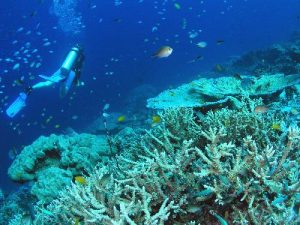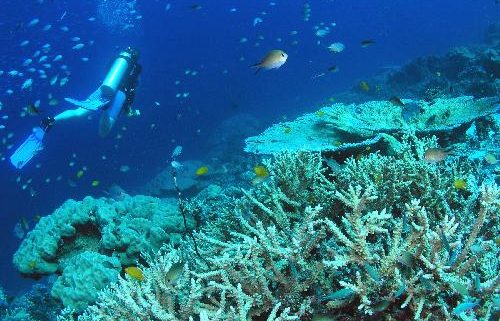Black Reefs Threaten Coral Diversity in the Line Islands
By Candice Canady,
Marine conservation student
Coral reefs are threatened globally and, without an undisturbed example from which to form a baseline, researchers are hard-pressed to predict how global and local stressors influence them. Luckily, a number of coral reefs exist in the Central and South Pacific that may hold the key to better understanding changes in reef populations worldwide. The Line Islands, located south of Hawaii, are home to some of the most pristine reefs in the world (Knowlton and Jackson 2008). These reefs have high biodiversity and have experienced very little influence from human populations (Barott 2013). However, they are threatened by their own unique set of stressors. The Central Pacific is traditionally an iron-poor region. This lack of iron reduces competition between coral and primary producers, such as algae and cyanobacteria (Martin and Fitzwater 1988). Recent studies have noted phase shifts (shifts from coral-dominated structures to regions dominated by algae) on coral reef atolls throughout the Pacific as a result of iron pollution (Kelly et al. 2012). These areas have been termed “black reefs” due to the dark-colored turf algae that covers the bottom (Barott 2013). A 2012 study by Kelly et al. showed that the black reefs in this area were introduced by shipwrecks that serve as point sources of iron pollution, causing algal and bacterial blooms that kill the natural coral reef structure.

Healthy coral reefs traditionally have a large amount of coral cover and serve as habitat for a variety of marine life. Black reefs (right) are characterized by dark turf algae and murky water, with little to no coral cover. Photo credit: Konstantin Tkachenko, Marine Photobank
To determine if iron leaching from shipwrecks was related to the occurrence of black reefs in the Line Islands, Kelly et al. 2012 compared three black reef sites, Millennium Atoll, Kingman Reef, and Tabuaeran Atoll, with healthy reference sites in the area. The authors set out to determine if decomposition of the wrecks increases iron, which is taken up by algae and allows it to outcompete local coral populations. In order to do this, the research team documented the various sites via photographs, analyzed algal tissues for the presence of iron, observed microbial abundances to determine if bacterial blooms aided in black reef development, and reproduced black reefs in the lab.
Sample photographs showed much lower coral densities and higher abundances of algae at the black reef sites when compared to healthy reefs in the area. Algal tissue samples from the Millennium black reef contained iron levels that were six times higher than that of healthy sites. Kelly et al. 2012 also hypothesized that harmful microbial blooms were causing further stress to the corals, aiding in these black reef phase shifts. Water samples collected from the black reef sites showed a higher prevalence of microbes than the reference site. The DNA from microbes at black reef sites was sequenced and compared to a database of known virulence genes. The comparison confirmed the authors’ hypothesis, showing a higher instance of pathogenic microbes at the black reef sites.
The results of these tests supported the groups’ hypothesis that iron leaching is likely the driving factor behind the emergence of black reefs in the Line Islands. However, the authors were not content to simply show the correlation between the presence of iron and black reef development in nature. In order to fully support their hypothesis, they attempted to replicate this mechanism in the lab. Using coral from healthy reference sites and rubble from the Tabuaeran black reef, they set up miniature reefs in one-liter Nalgene bottles. These mini-reefs were then subjected to various treatments (shown below) and allowed to incubate for five days. The highest coral mortality was noted in the mini-reefs where coral, rubble, and iron were all placed together. Corals had a greater survival rate in the mini-reefs where antibiotics were added, providing further support for the hypothesis that pathogenic microbes are also a factor in the development of black reefs. Dissolved oxygen levels were tested at the end of the five day period, and the bottles that had developed black reefs were found to be anoxic.
- Coral
- Coral + antibiotic
- Coral + iron
- Coral + iron + antibiotic
- Coral + rubble
- Coral + rubble + antibiotic
- Coral + rubble + iron
- Coral + rubble + iron + antibiotic
The Kelly et al. 2012 study successfully demonstrated that the increase in bioavailable iron from shipwrecks in the Line Islands is directly correlated with the development of black reefs in the area. This finding has major implications, not only for the Line Islands, but for reefs in other iron-poor regions of the Pacific as well. Shipwrecks have been documented at other sites in the Central Pacific, and iron pollution can come from other unexpected sources, such as wildfires (Abram et al. 2003; Sandin et al. 2008; Schroeder et al. 2008; Work et al. 2008). Iron fertilization has even been suggested as a means of reducing the effects of carbon pollution. It is crucial that the potential impact on traditionally iron-deficient regions of the ocean be considered in such management plans.
While the loss of coral diversity on black reefs is tragic, there is hope for preventing further devastation. If the shipwrecks at the five known locations in the Line Islands are removed, it is likely that their associated black reefs will not develop any further. With time, these sites may even improve. Kingman Reef and Palmyra Atoll are both protected as U.S. Marine National Monuments. However, no effort has yet been made to remove the wrecks from these areas (Barott 2013). In response, the Marine Conservation Institute has started a petition to bring attention to the black reefs in these two areas and convince the U.S. Department of the Interior to remove the wreckage (to sign the petition, see the link below). With such a wide variety of pressures on reefs today, it is rare that the opportunity to save one of these habitats has been so readily available. It is imperative that the destruction caused by algal and bacterial blooms in the Line Islands be stopped so that these reefs can be studied to aid in conservation of other reefs worldwide.
To sign the petition, please visit the Marine Conservation Institute at:
http://www.marine-conservation.org/take-action/action-alert-shipwreck-removal/
REFERENCES
Abram NJ, Gagan MK, McCullock MT, Chappell J, Hantoro WS, (2003) Coral reef death during the 1997 Indian Ocean dipole linked to Indonesian wildfires. Science 301: 952-955
Barott KI (2013) Black reefs: an in-depth look into the little-known problem of how shipwrecks are destroying some of our most pristine coral reefs. Coral & Reef USA 2013 2:68-73.
Kelly LW, Barott KI, Dinsdale E, Friedlander AM, Nosrat B, Obdura D, Sala E, Sandin SA, Smith JE, Vermeij MJ, Willimas GJ, Willner D, Rohwer F (2012) Black reefs: Iron-induced phase shifts on coral reefs. The ISME Journal 6:638-649 http://dx.doi.org/10.1038/ismej.2011.114
Knowlton N, Jackson JBC (2008) Shifting baselines, local impacts, and global change on coral reefs. PLoS Biol 6:215-220
Marine Conservation Institute (2011) Action alert: shipwreck removal. Accessed 6 Oct. http://www.marine-conservation.org/take-action/action-alert-shipwreck-removal/
Martin JH, Fitzwater SE (1988). Iron-deficiency limits phytoplankton growth in the northeast Pacific Subarctic. Nature 331:341-343
Sandin SA, Smith JE, DeMartini EE, Dinsdale EA, Donner SD, Friedlander AM et al. (2008) Baselines and degradation of coral reefs in the northern Line Islands. PloS One 3:e1548
Schroeder RE, Green AL, DeMartini EE, Kenyon JC (2008) Long-term effects of a ship-grounding on coral reef fish assemblages at Rose Atoll, American Samoa. Bull Marine Sci 82:345-364
Work TM, Aeby GS, Maragos JE (2008) Phase shift from a coral to a corallimorph-dominated reef associated with a shipwreck on Palmyra Atoll. PLoS One 3:e2989




Leave a Reply
Want to join the discussion?Feel free to contribute!